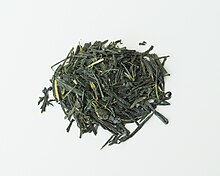Bancha: Difference between revisions
ReboteBoleo (talk | contribs) 1) Added citation backing up "lowest grade of tea" from a published cookbook (Japanese Cooking: A Simple Art). 2) Edited previously existing reference link to include author and name of site (Xenia Blanco, The Japanese Tea Hub). 3) Removed "citation needed" banner. |
m v2.04b - Bot T20 CW#61 - Fix errors for CW project (Reference before punctuation - Empty list item) |
||
| Line 9: | Line 9: | ||
| Tea_quick = More widely available in [[Western World|the West]]. A late season crop, goes well with food. |
| Tea_quick = More widely available in [[Western World|the West]]. A late season crop, goes well with food. |
||
}} |
}} |
||
{{nihongo|'''''Bancha'''''|番茶}} is a type of [[Japan]]ese [[green tea]]. It is harvested from the second flush of ''[[sencha]]'' between summer and autumn<ref>{{Cite web|last=Xenia|first=Blanco|date=Aug 24, 2020|title=Let's talk about bancha!|url=https://www.thejapaneseteahub.com/post/let-s-talk-about-bancha^|url-status=live|archive-url=|archive-date=|access-date=|website=The Japanese Tea Hub}}</ref> |
{{nihongo|'''''Bancha'''''|番茶}} is a type of [[Japan]]ese [[green tea]]. It is harvested from the second flush of ''[[sencha]]'' between summer and autumn.<ref>{{Cite web|last=Xenia|first=Blanco|date=Aug 24, 2020|title=Let's talk about bancha!|url=https://www.thejapaneseteahub.com/post/let-s-talk-about-bancha^|url-status=live|archive-url=|archive-date=|access-date=|website=The Japanese Tea Hub}}</ref> (The first flush is harvested for ''[[shincha]]''.) |
||
It can be found in a number of forms such as roasted, unroasted, smoked, matured or fermented for three years and even post-fermented. For example, [[goishicha]]. |
It can be found in a number of forms such as roasted, unroasted, smoked, matured or fermented for three years and even post-fermented. For example, [[goishicha]]. |
||
==Background== |
==Background== |
||
Bancha is harvested from the same tea tree as ''sencha'' grade, but it is plucked later than ''sencha'' is, giving it a lower market grade. It is considered to be one of the lowest grades of Japanese green teas<ref>{{Cite book|last=Tsuji|first=Shizuo|title=Japanese Cooking: A Simple Art|publisher=Kodansha International|year=2007|isbn=1568363885|location=Japan|pages=332}}</ref> |
Bancha is harvested from the same tea tree as ''sencha'' grade, but it is plucked later than ''sencha'' is, giving it a lower market grade. It is considered to be one of the lowest grades of Japanese green teas.<ref>{{Cite book|last=Tsuji|first=Shizuo|title=Japanese Cooking: A Simple Art|publisher=Kodansha International|year=2007|isbn=1568363885|location=Japan|pages=332}}</ref> There are 22 grades of ''bancha''. Its flavour is unique and varies depending on the type. |
||
Flavours range from smoke, roasted nuts, green grass, earth, soil, wet leaves, some of the types of bancha have a stronger straw smell. |
Flavours range from smoke, roasted nuts, green grass, earth, soil, wet leaves, some of the types of bancha have a stronger straw smell. |
||
| Line 27: | Line 27: | ||
* |
|||
{{Japanese food and drink}} |
{{Japanese food and drink}} |
||
{{Teas}} |
{{Teas}} |
||
Revision as of 09:37, 18 December 2020
| Bancha | |
|---|---|
 | |
| Type | Green |
| Other names | Common Tea |
| Origin | Japan |
| Quick description | More widely available in the West. A late season crop, goes well with food. |
Bancha (番茶) is a type of Japanese green tea. It is harvested from the second flush of sencha between summer and autumn.[1] (The first flush is harvested for shincha.)
It can be found in a number of forms such as roasted, unroasted, smoked, matured or fermented for three years and even post-fermented. For example, goishicha.
Background
Bancha is harvested from the same tea tree as sencha grade, but it is plucked later than sencha is, giving it a lower market grade. It is considered to be one of the lowest grades of Japanese green teas.[2] There are 22 grades of bancha. Its flavour is unique and varies depending on the type.
Flavours range from smoke, roasted nuts, green grass, earth, soil, wet leaves, some of the types of bancha have a stronger straw smell.
See also
- Hōjicha – often made from bancha
- Japanese tea
References
- ^ Xenia, Blanco (Aug 24, 2020). "Let's talk about bancha!". The Japanese Tea Hub.
{{cite web}}: CS1 maint: url-status (link) - ^ Tsuji, Shizuo (2007). Japanese Cooking: A Simple Art. Japan: Kodansha International. p. 332. ISBN 1568363885.
